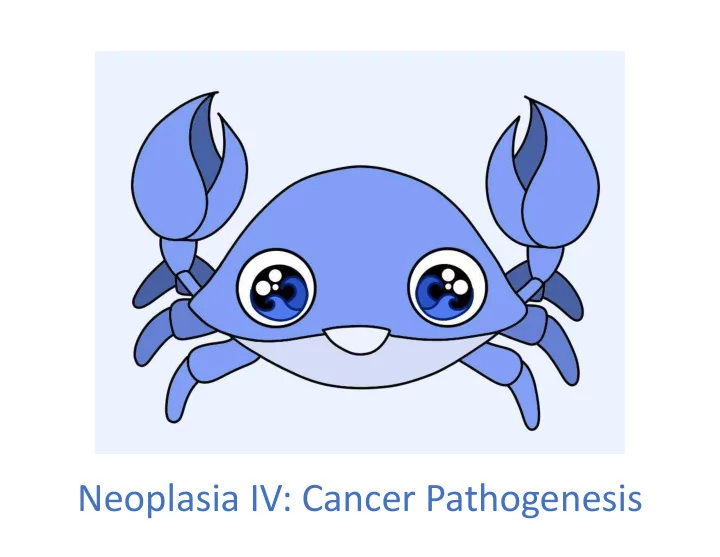

Neoplasia IV: Cancer Pathogenesis
Cancer Pathogenesis Lecture Objectives • Briefly answer, in your own words, the question “What causes cancer?” • List the eight characteristics (or hallmarks) of cancer cells that make them different from normal cells. • Explain what proto-oncogenes and oncogenes are. • Describe what the RAS protein normally does, and explain how it causes cancer when it is mutated. • Describe what tumor suppressor genes are. • Describe what the RB protein normally does, and explain how it causes cancer when it is mutated. • Describe the normal functions of p53, and explain why it’s mutated in most tumors.
Cancer Pathogenesis Lecture Objectives • Describe the normal function of telomeres, and explain how tumor cells exploit this function. • Describe the basic steps involved in invasion and metastasis. • Explain what the Warburg effect is, and explain why tumor cells opt to use it. • List some ways tumor cells can evade immune detection.
What causes cancer? Non-lethal genetic damage.
Hallmarks of Cancer Evasion of Autonomous immune detection cell proliferation Resistance to Altered growth-suppressing metabolism signals Ability to invade Evasion of and metastasize apoptosis Angiogenesis Immortality
Hallmarks of Cancer Autonomous cell proliferation
Autonomous Cell Growth • Proto-oncogene: a normal gene whose product promotes cell growth. • Oncogene: a mutated proto-oncogene. Causes tumor cell to grow autonomously. • Oncoprotein: the product of an oncogene.
The RAS Gene • RAS is a signal transduction protein • Mutated RAS is always on… • …therefore, always transducing signals… • …therefore, cell is always dividing.
Hallmarks of Cancer Autonomous cell proliferation Resistance to growth-suppressing signals
Resistance to Growth-Suppressing Signals • Tumor suppressor gene: a normal gene whose product suppresses the cell cycle (like brakes on a car). • Mutate these guys, and you lose the brakes! • Must mutate both copies of the gene to cause tumors.
The Retinoblastoma (RB) Gene • RB gene product stops cell at G 1 checkpoint • Mutant RB is inactive; lets cells pass through G 1 ! • Patients with two mutated RB genes have very high risk of retinoblastoma (and an increased risk of getting other tumors).
The Cell Cycle
Retinoblastoma
Hallmarks of Cancer Autonomous cell proliferation Resistance to growth-suppressing signals Evasion of apoptosis
Evasion of Apoptosis • Many proteins are involved in apoptosis: • p53 • Fas (the “death receptor”) • Executioner caspases • BCL2 protein family • If genes for these proteins are mutated, the cell will be able to avoid killing itself.
The p53 Gene • Nickname for p53: “guardian of the genome” • If a cell’s DNA is damaged, p53 causes a pause in the cell cycle (via RB), so DNA can be repaired. • If DNA damage is irreparable, p53 causes the cell to undergo apoptosis. • Most human tumors have p53 mutations!
p53 activated p53 not activated no cell cycle arrest, cell cycle arrest no DNA repair
Hallmarks of Cancer Autonomous cell proliferation Resistance to growth-suppressing signals Evasion of apoptosis Immortality
Immortality • Normal cells can only undergo 60-70 doublings • Main reason: telomere shortening! • Stem cells and cancer cells use telomerase to maintain telomere length and keep replicating.
Telomeres As cells divide over time...
Hallmarks of Cancer Autonomous cell proliferation Resistance to growth-suppressing signals Evasion of apoptosis Angiogenesis Immortality
Angiogenesis • Tumor cells need blood too! • Can’t grow >1-2 cm without new vessels • Tumor cells eventually learn how to stimulate angiogenesis • Lots of cytokines involved (i.e., VEGF)
Tumor cells surrounding new vessel
Hallmarks of Cancer Autonomous cell proliferation Resistance to growth-suppressing signals Ability to invade Evasion of and metastasize apoptosis Angiogenesis Immortality
Ability to Invade and Metastasize To do this, tumor cells must: • Loosen contacts between cells • Degrade extracellular matrix • Migrate away from the original site Some tumors lodge in nearest capillary bed; other tumors show tropism.
clonal growth metastatic subclone intravasation tumor cell embolus extravasation
Tumor cells surrounding and invading vessel
Hallmarks of Cancer Autonomous cell proliferation Resistance to Altered growth-suppressing metabolism signals Ability to invade Evasion of and metastasize apoptosis Angiogenesis Immortality
Altered Metabolism • Normal cells, when oxygen is around, use oxidative phosphorylation to generate ATP. • Cancer cells are different! • They take up tons of glucose, and convert it to lactate via the glycolytic pathway. • This is called aerobic glycolysis, or the “Warburg effect.”
Rapidly Normal cells Tumor cells dividing cells O 2 present O 2 absent O 2 present or absent Oxidative Anaerobic Anaerobic phosphorylation respiration respiration 36 ATP per glucose 2 ATP per glucose 2 ATP per glucose
Rapidly Normal cells Tumor cells dividing cells O 2 present O 2 absent O 2 present DNA structural RNA proteins lipids organelles Oxidative Anaerobic Anaerobic phosphorylation respiration respiration 36 ATP per glucose 2 ATP per glucose 2 ATP per glucose
Hallmarks of Cancer Evasion of Autonomous immune detection cell proliferation Resistance to Altered growth-suppressing metabolism signals Ability to invade Evasion of and metastasize apoptosis Angiogenesis Immortality
Recommend
More recommend